service MERCEDES-BENZ METRIS 2016 MY16 Operator’s Manual
[x] Cancel search | Manufacturer: MERCEDES-BENZ, Model Year: 2016, Model line: METRIS, Model: MERCEDES-BENZ METRIS 2016Pages: 310, PDF Size: 7.28 MB
Page 28 of 310
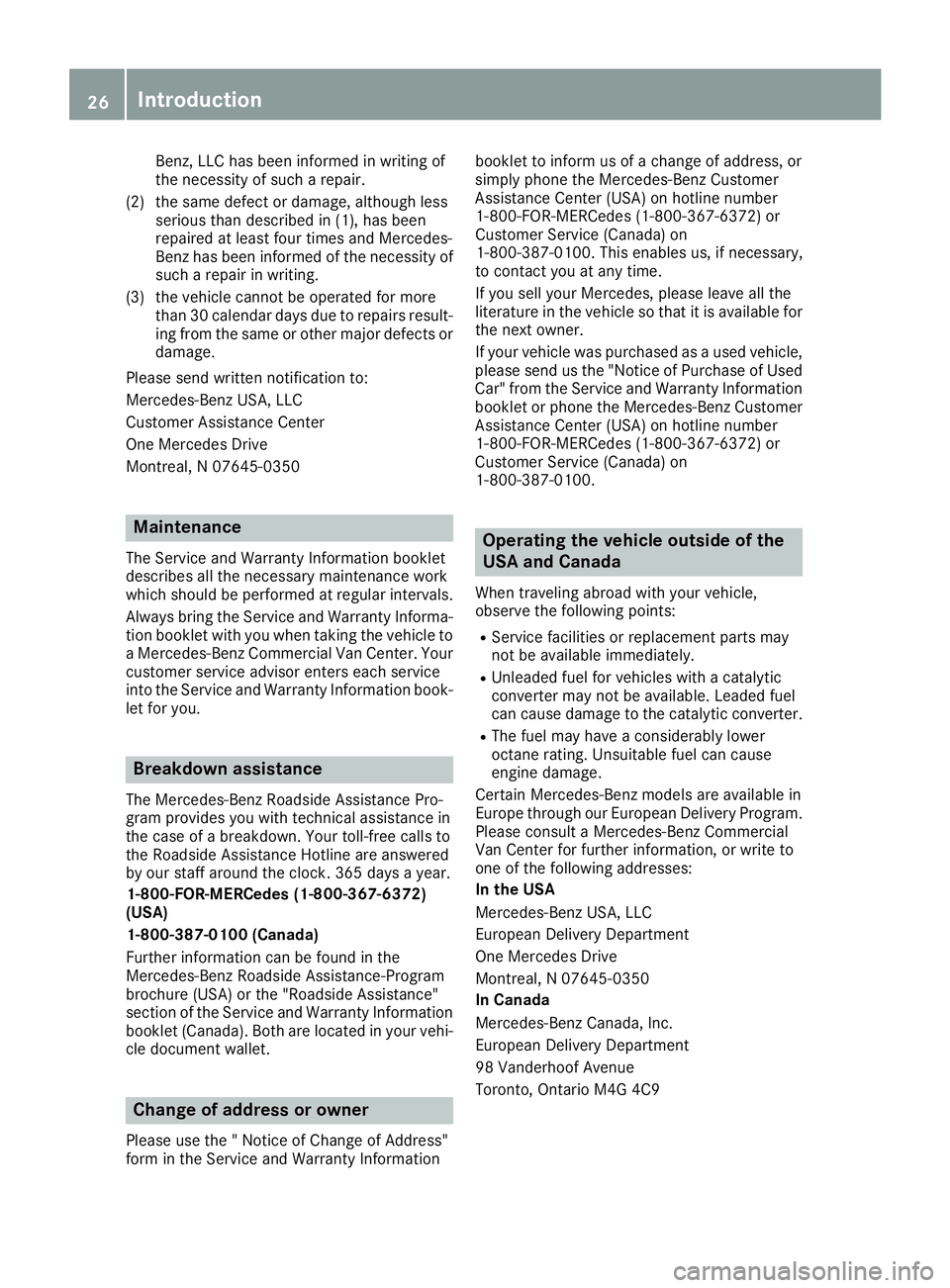
Benz, LLC has beeninformed in writing of
the necessity of such arepair.
(2) the sam edefect or damage, although less
serioust han described in (1) ,has been
repaired at least fou rtimes and Mercedes-
Benz has bee ninformed of the necessity of
such arepai rinw riting.
(3) the vehicle cannot be operate dfor more
than 30 calenda rdaysd ue to repairs result-
ing from the sam eorother majo rdefects or
damage.
Please send written notification to:
Mercedes-Benz USA, LLC
CustomerA ssistance Center
One Mercedes Drive
Montreal ,N07645-0350
Maintenance
The Service and Warranty Information booklet
describes al lthe necessar ymaintenance work
which should be performe datregula rintervals.
Alway sbring the Service and Warranty Informa-
tion booklet with yo uwhent aking the vehicle to
aM ercedes-Benz Commercial Van Center. Your
customer service adviso renters each service
into the Service and Warranty Information book-
let for you.
Breakdown assistance
The Mercedes-Benz Roadsid eAssistance Pro-
gramp rovides yo uwitht echnical assistance in
the case of abreakdown. You rtoll-free calls to
the Roadsid eAssistance Hotline are answered
by ours taff around the clock. 365 days ayear.
1-800-FOR-MERCedes (1-800-367-6372)
(USA)
1-800-387-0100 (Canada)
Further information can be found in the
Mercedes-Benz Roadsid eAssistance-Program
brochure (USA) or the "Roadside Assistance"
section of the Service and Warranty Information booklet (Canada). Both are located in your vehi-
cle document wallet.
Change of address or owner
Please use the "Notice of Change of Address"
form in the Service and Warranty Information booklet to infor
musofachangeofa ddress, or
simplyp hone the Mercedes-Benz Customer
Assistance Center (USA) on hotline number
1-800-FOR-MERCede s(1-800-367-6372) or
Customer Servic e(Ca nada )on
1-800-387-0100 .Thise nables us ,ifnecessary,
to contact yo uatany time.
If yo uselly ou rM ercedes, please leave al lthe
literature in the vehicl esothatiti savailable for
the next owner.
If your vehicl ewaspurchased as ausedv ehicle,
please send us the "Notice of Purchase of Used
Car" from the Service and Warranty Information
bookle torphone the Mercedes-Benz Customer
Assistance Center (USA) on hotline number
1-800-FOR-MERCedes (1-800-367-6372) or
Customer Service (Canada )on
1-800-387-0100.
Operatin gthe vehicle outside of the
USA and Canada
Whe ntraveling abroa dwithy ourv ehicle,
observe the following points:
RService facilities or replacement parts may
not be available immediately.
RUnleade dfuelfor vehicles with acatalytic
converter may not be available .Leade dfuel
can cause damag etothe catalytic converter.
RThe fue lmay have aconsiderably lower
octane rating. Unsuitabl efuelcan cause
engine damage.
Certai nMercedes-Benz model sare available in
Europe throug hourEuropean Delivery Program.
Please consult aMercedes-Benz Commercial
VanC enter for further information, or write to
one of the following addresses:
In the USA
Mercedes-Benz USA, LLC
European Delivery Department
One Mercedes Drive
Montreal, N07645-0350
In Canada
Mercedes-Benz Canada, Inc.
European Delivery Department
98 Vanderhoof Avenue
Toronto, Ontario M4G 4C9
26Introduction
Page 30 of 310
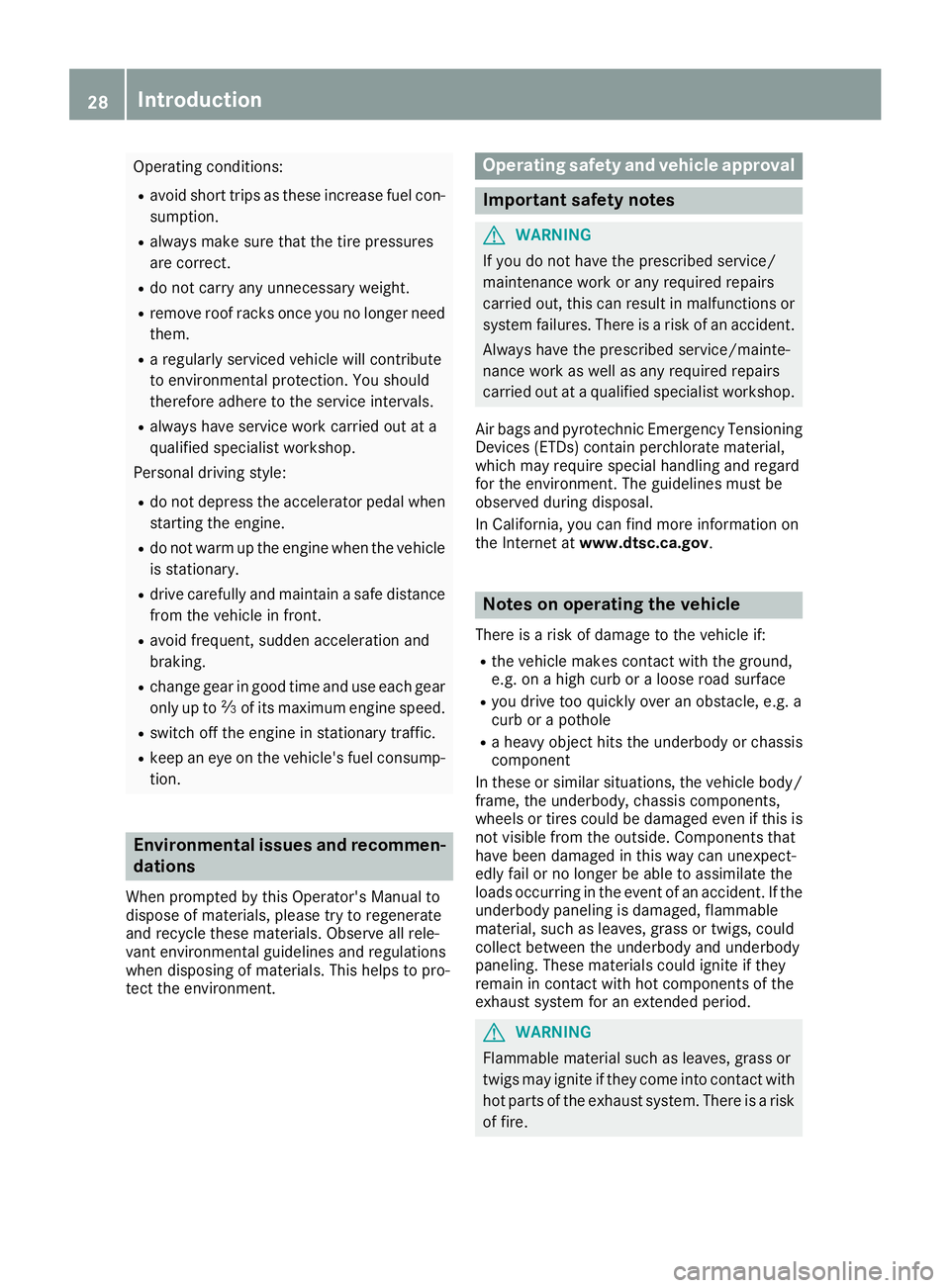
Operating conditions:
Ravoid short trips as these increase fuel con-
sumption.
Ralways make sure that the tire pressures
are correct.
Rdo not carry any unnecessary weight.
Rremove roof racks once you no longer need
them.
Raregularly serviced vehicle will contribute
to environmental protection. You should
therefore adhere to the service intervals.
Ralways have service work carried out at a
qualified specialist workshop.
Personal driving style:
Rdo not depress the accelerator pedal when
starting the engine.
Rdo not warm up the engine when the vehicle
is stationary.
Rdrive carefully and maintain asafe distance
from the vehicle in front.
Ravoid frequent, sudden acceleration and
braking.
Rchange gear in good time and use each gear
only up to Ôof its maximum engine speed.
Rswitch off the engine in stationary traffic.
Rkeep an eye on the vehicle's fuel consump-
tion.
Environmental issues and recommen-
dations
When prompted by this Operator's Manual to
dispose of materials, please try to regenerate
and recycle these materials. Observe all rele-
vant environmental guidelines and regulations
when disposing of materials. This helps to pro-
tect the environment.
Operating safety and vehiclea pproval
Important safety notes
GWARNING
If you do not have the prescribed service/
maintenance work or any required repairs
carried out, this can result in malfunctions or system failures. There is arisk of an accident.
Alwaysh ave the prescribed service/mainte-
nance work as well as any required repairs
carried out at aqualified specialist workshop.
Air bags and pyrotechnic EmergencyT ensioning
Devices (ETDs) contain perchlorate material,
which may require special handling and regard
for the environment.T he guidelines must be
observed during disposal.
In California, you can find more information on
the Internet at www.dtsc.ca.gov.
Notes on operating the vehicle
There isarisk of damage to the vehicle if:
Rthe vehicle makes contact with the ground,
e.g. on ahigh curb or aloose road surface
Ryou drive too quickly over an obstacle, e.g. a
curb or apothole
Raheavy object hits the underbody or chassis
component
In these or similars ituations, the vehicle body/
frame, the underbody,c hassis components,
wheels or tires could be damaged even if this is
not visible from the outside. Components that
have been damaged in this way can unexpect-
edly fail or no longer be able to assimilate the
loads occurring in the event of an accident. If the underbody paneling is damaged,f lammable
material, such as leaves, grass or twigs, could
collect between the underbody and underbody
paneling. These materials could ignite if they
remain in contact with hot componentsoft he
exhaust system for an extended period.
GWARNING
Flammable material such as leaves, grass or
twigs may ignite if they come into contact with
hot parts of the exhaust system. There is arisk
of fire.
28Introduction
Page 31 of 310
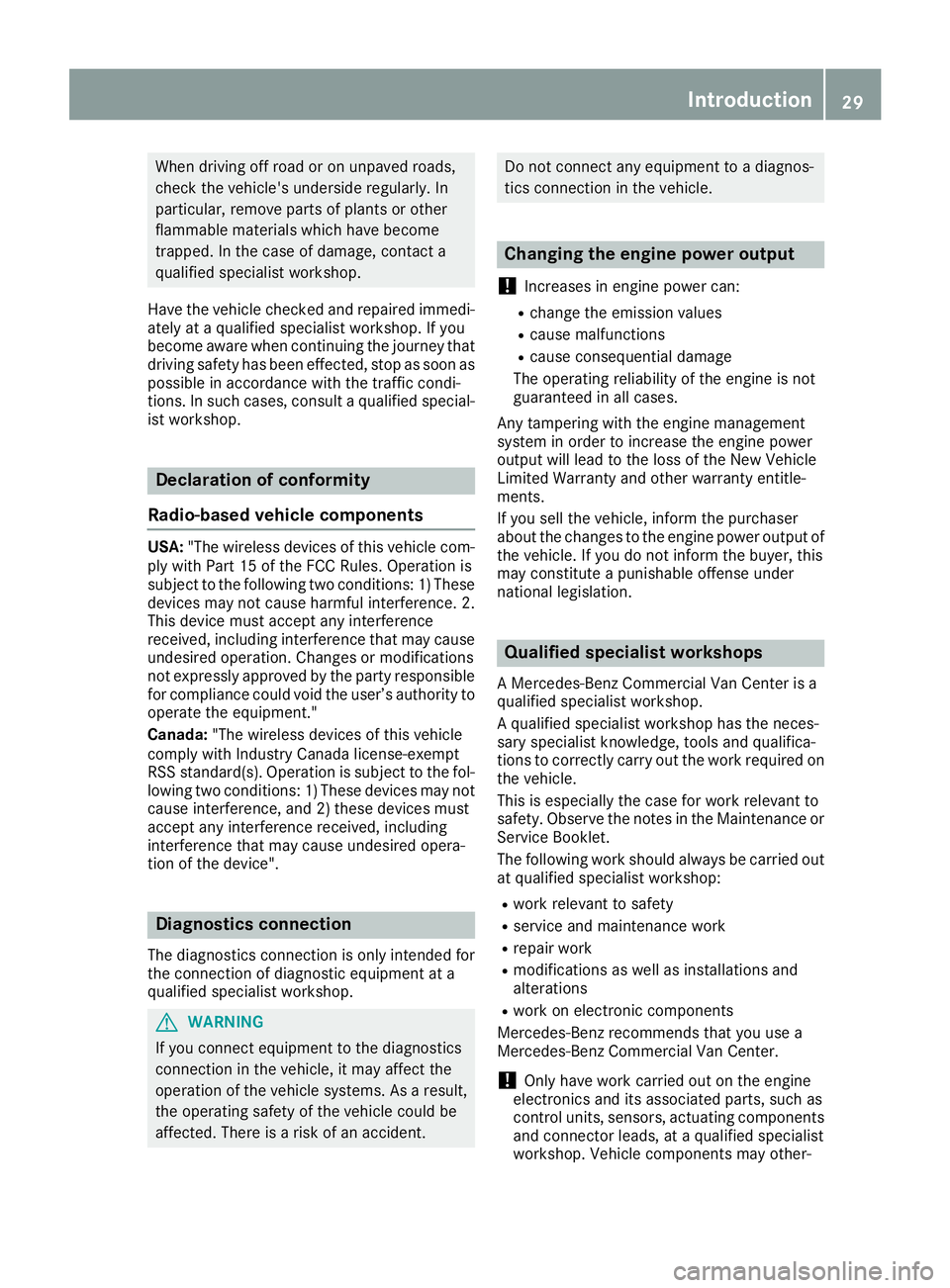
When driving off road or on unpaved roads,
check the vehicle's underside regularly. In
particular, remove parts of plants or other
flammable materials which have become
trapped. In the case of damage, contact a
qualified specialist workshop.
Have the vehicle checked and repaired immedi-
ately at aqualified specialist workshop. If you
become aware when continuing the journey that
driving safety has been effected, stop as soon as
possible in accordance with the traffic condi-
tions .Insuch cases, consult aqualified special-
ist workshop.
Declaration of conformity
Radio-based vehicle components
USA: "The wireless devices of this vehicle com-
ply with Part 15 of the FCC Rules. Operation is
subject to the following two conditions: 1) These
devices may not cause harmful interference. 2.
This device must accept any interference
received, including interference that may cause
undesired operation. Changes or modifications
not expressly approved by the party responsible
for complianc ecould void the user’s authority to
operate the equipment."
Canada: "The wireless devices of this vehicle
comply with Industry Canada license-exempt
RSS standard(s). Operation is subject to the fol-
lowing two conditions: 1) These devices may not
cause interference, and 2) these devices must
accept any interference received, including
interference that may cause undesired opera-
tion of the device".
Diagnostics connection
The diagnostic sconnection is only intended for
the connection of diagnostic equipment at a
qualified specialist workshop.
GWARNING
If you connect equipment to the diagnostics
connection in the vehicle, it may affect the
operation of the vehicle systems. As aresult,
the operating safety of the vehicle could be
affected. There is arisk of an accident.
Do not connect any equipment to adiagnos-
tics connection in the vehicle.
Changing the engine power output
!
Increases in engine power can:
Rchange the emission values
Rcause malfunctions
Rcause consequential damage
The operating reliability of the engine is not
guaranteed in all cases.
An ytamperin gwith the engine management
system in order to increase the engine power
output will lead to the loss of the New Vehicle
Limited Warrant yand other warranty entitle-
ments.
If you sell the vehicle, inform the purchaser
about the changes to the engine power output of
the vehicle. If you do not inform the buyer, this
may constitut eapunishable offense under
national legislation.
Qualified specialist workshops
AM ercedes-Benz Commercial Van Center is a
qualified specialist workshop.
Aq ualified specialist workshop has the neces-
sary specialist knowledge, tools and qualifica-
tions to correctly carry out the work required on
the vehicle.
This is especially the case for work relevant to
safety. Observe the notes in the Maintenance or
ServiceB ooklet.
The following work should alwaysbec arried out
at qualified specialist workshop:
Rwork relevant to safety
Rservice and maintenance work
Rrepair work
Rmodifications as well as installations and
alterations
Rwork on electronic components
Mercedes-Benz recommends that you use a
Mercedes-Benz Commercial Van Center.
!Only have work carried out on the engine
electronics and its associated parts, such as
control units, sensors, actuatin gcomponents
and connecto rleads, at aqualified specialist
workshop. Vehicle componentsm ay other-
Introduction29
Z
Page 34 of 310
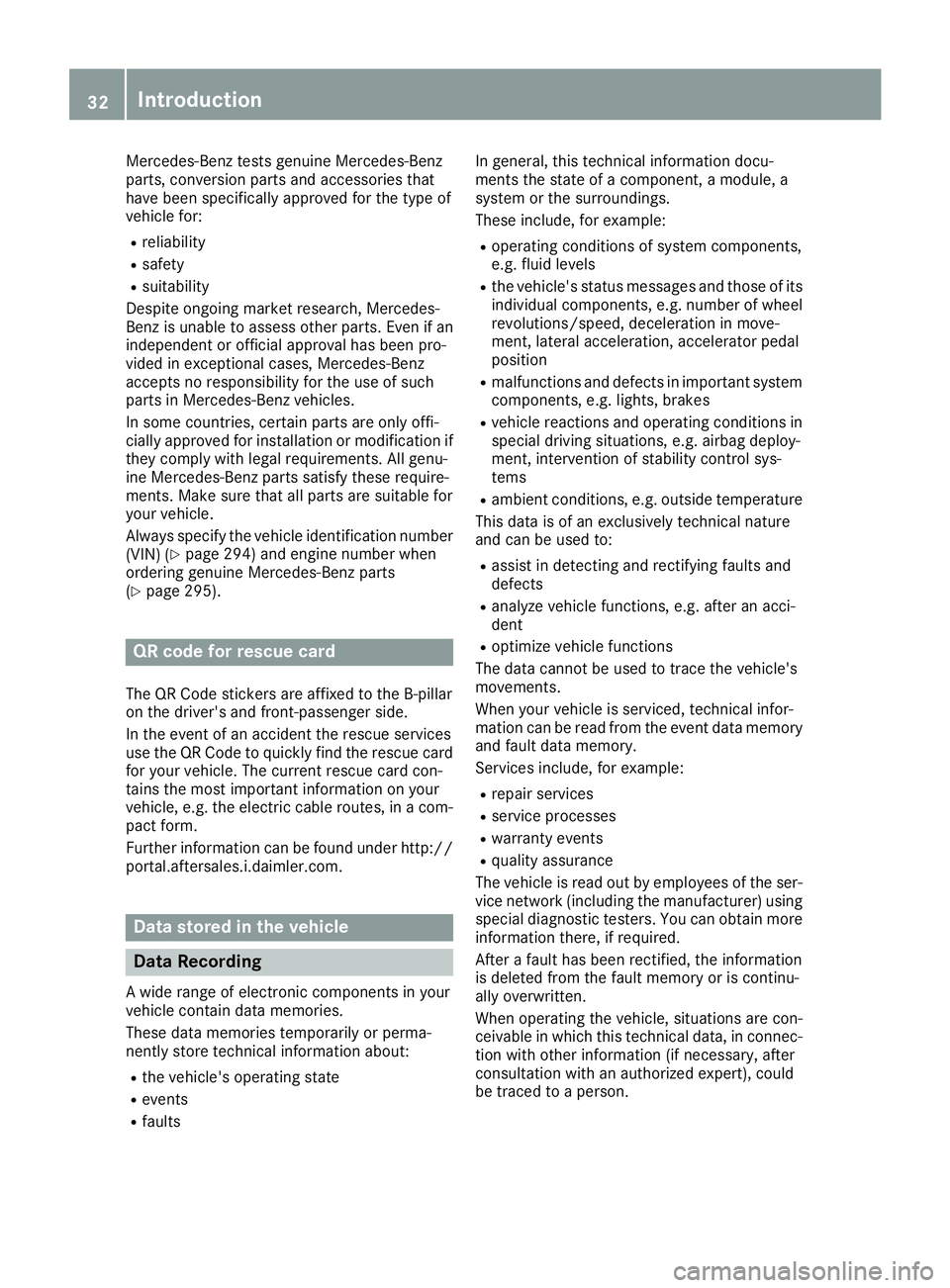
Mercedes-Benztests genuine Mercedes-Benz
parts, conversion parts and accessories that
have been specifically approved for the type of
vehicle for:
Rreliability
Rsafety
Rsuitability
Despite ongoing market research, Mercedes-
Benz is unable to assess other parts. Even if an
independent or official approval has been pro-
vided in exceptional cases, Mercedes-Benz
accepts no responsibility for the use of such
parts in Mercedes-Benzv ehicles.
In some countries, certain parts are only offi-
cially approved for installation or modification if
they comply with legal requirements. All genu-
ine Mercedes-Benzp arts satisfy these require-
ments .Make sure that all parts are suitable for
your vehicle.
Always specify the vehicle identification number
(VIN) (
Ypage 294) and engine number when
ordering genuine Mercedes-Benzp arts
(
Ypage 295).
QR code for rescue card
The QR Code stickers are affixed to the B-pillar
on the driver's and front-passenger side.
In the event of an accident the rescue services
use the QR Code to quickly find the rescue card
for your vehicle. The current rescue card con-
tains the most important information on your
vehicle, e.g. the electric cable routes, in acom-
pact form.
Further information can be found under http://
portal.aftersales.i.daimler.com.
Data stored in the vehicle
Data Recording
Aw ide range of electronic components in your
vehicle contain data memories.
These data memories temporarily or perma-
nently store technical information about:
Rthe vehicle's operating state
Revents
Rfaults In general, this technical information docu-
ments the state of
acomponent, amodule, a
system or the surroundings.
These include, for example:
Roperating conditionsofs ystem components,
e.g. fluid levels
Rthe vehicle's status messages and those of its
individual components, e.g. number of wheel
revolutions/speed, deceleration in move-
ment, lateral acceleration, accelerator pedal
position
Rmalfunctions and defects in important system
components, e.g. lights, brakes
Rvehicle reactions and operating conditionsi n
special driving situations, e.g. airbag deploy-
ment, intervention of stability control sys-
tems
Rambient conditions, e.g. outside temperature
This data is of an exclusively technical nature
and can be used to:
Rassist in detectin gand rectifying faults and
defects
Ranalyze vehicle functions, e.g. after an acci-
dent
Roptimize vehicle functions
The data cannot be used to trace the vehicle's
movements.
When your vehicle is serviced, technical infor-
mation can be read from the event data memory
and fault data memory.
Services include, for example:
Rrepair services
Rservice processes
Rwarranty events
Rquality assurance
The vehicle is read out by employees of the ser- vice network (including the manufacturer) using
special diagnostic testers .You can obtain more
information there, if required.
After afault has been rectified, the information
is deleted from the fault memory or is continu-
ally overwritten.
When operating the vehicle, situations are con-
ceivable in which this technical data, in connec-
tion with other information (if necessary, after
consultation with an authorized expert), could
be traced to aperson.
32Introduction
Page 79 of 310
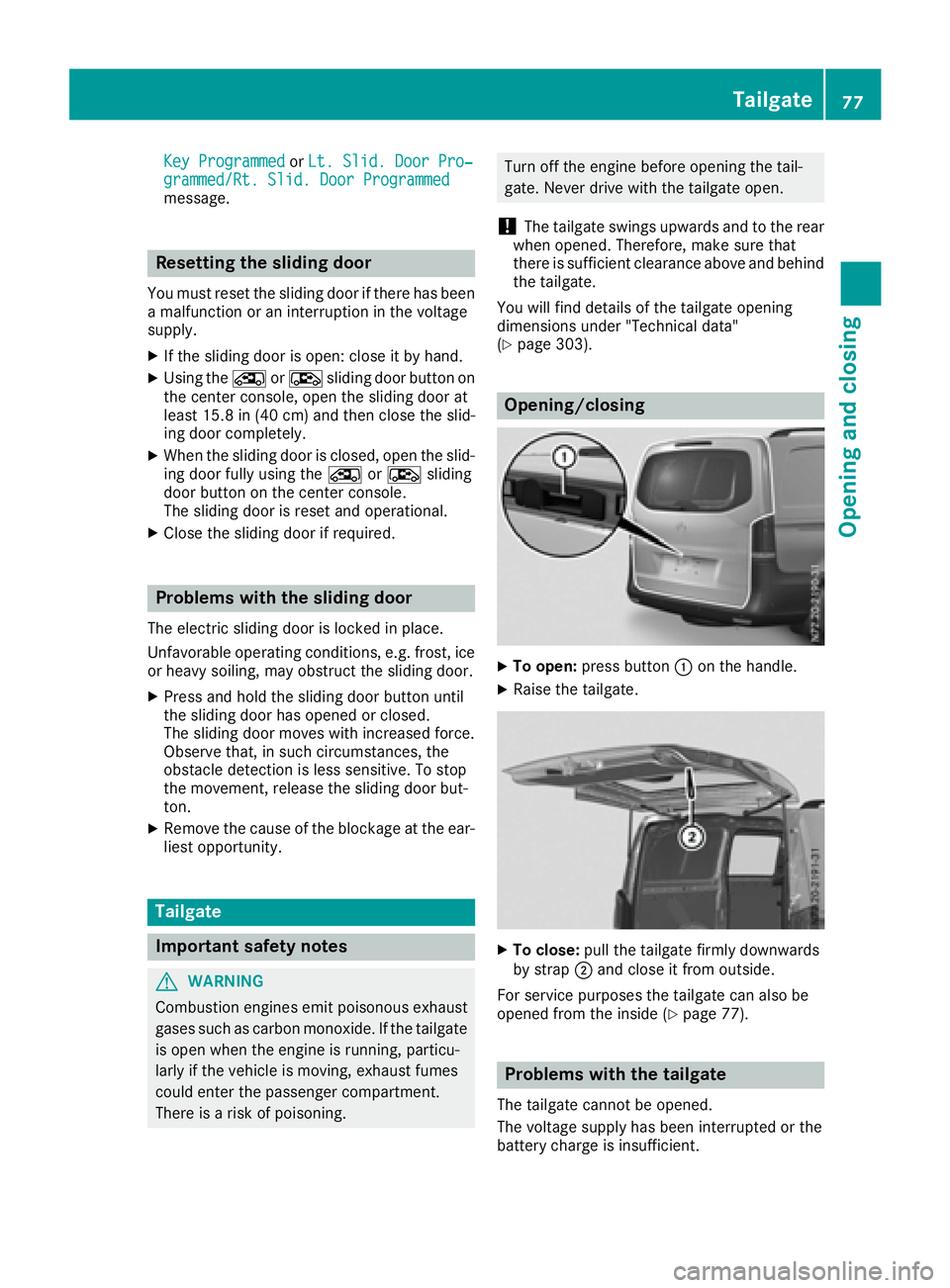
Key ProgrammedorLt. Slid. Door Pro‐grammed/Rt. Slid. Door Programmedmessage.
Resetting the sliding door
You must reset the sliding door if there has been
am alfunction or an interruption in the voltage
supply.
XIf the sliding door is open: close it by hand.
XUsing the ÅorÆ sliding door button on
the center console, open the sliding door at
least 15.8 in (40 cm )and then close the slid-
ing door completely.
XWhen the sliding door is closed, open the slid-
ing door fully using the ÅorÆ sliding
door button on the center console.
The sliding door is reset and operational.
XClose the sliding door if required.
Problems with the sliding door
The electric sliding door is locked in place.
Unfavorable operating conditions, e.g. frost, ice
or heavy soiling, may obstruct the sliding door.
XPress and hold the sliding door button until
the sliding door has opened or closed.
The sliding door moves with increased force.
Observe that, in such circumstances, the
obstacle detection is less sensitive. To stop
the movement, release the sliding door but-
ton.
XRemove the cause of the blockage at the ear-
liest opportunity.
Tailgate
Important safety notes
GWARNING
Combustion engines emit poisonous exhaust
gases such as carbon monoxide. If the tailgate
is open when the engine is running, particu-
larly if the vehicle is moving, exhaust fumes
could enter the passenger compartment.
There is arisk of poisoning.
Turn off the engine before opening the tail-
gate. Never drive with the tailgate open.
!The tailgate swings upwards and to the rear
when opened. Therefore, make sure that
there is sufficient clearance above and behind
the tailgate.
You will find details of the tailgate opening
dimensions under "Technical data"
(
Ypage 303).
Opening/closing
XTo open: press button :on the handle.
XRaise the tailgate.
XTo close: pull the tailgate firmly downwards
by strap ;and close it from outside.
For service purposes the tailgate can also be
opened from the inside (
Ypage 77).
Problems with the tailgate
The tailgate cannot be opened.
The voltage supplyh as been interrupted or the
battery charge is insufficient.
Tailgate77
Opening and closing
Z
Page 105 of 310
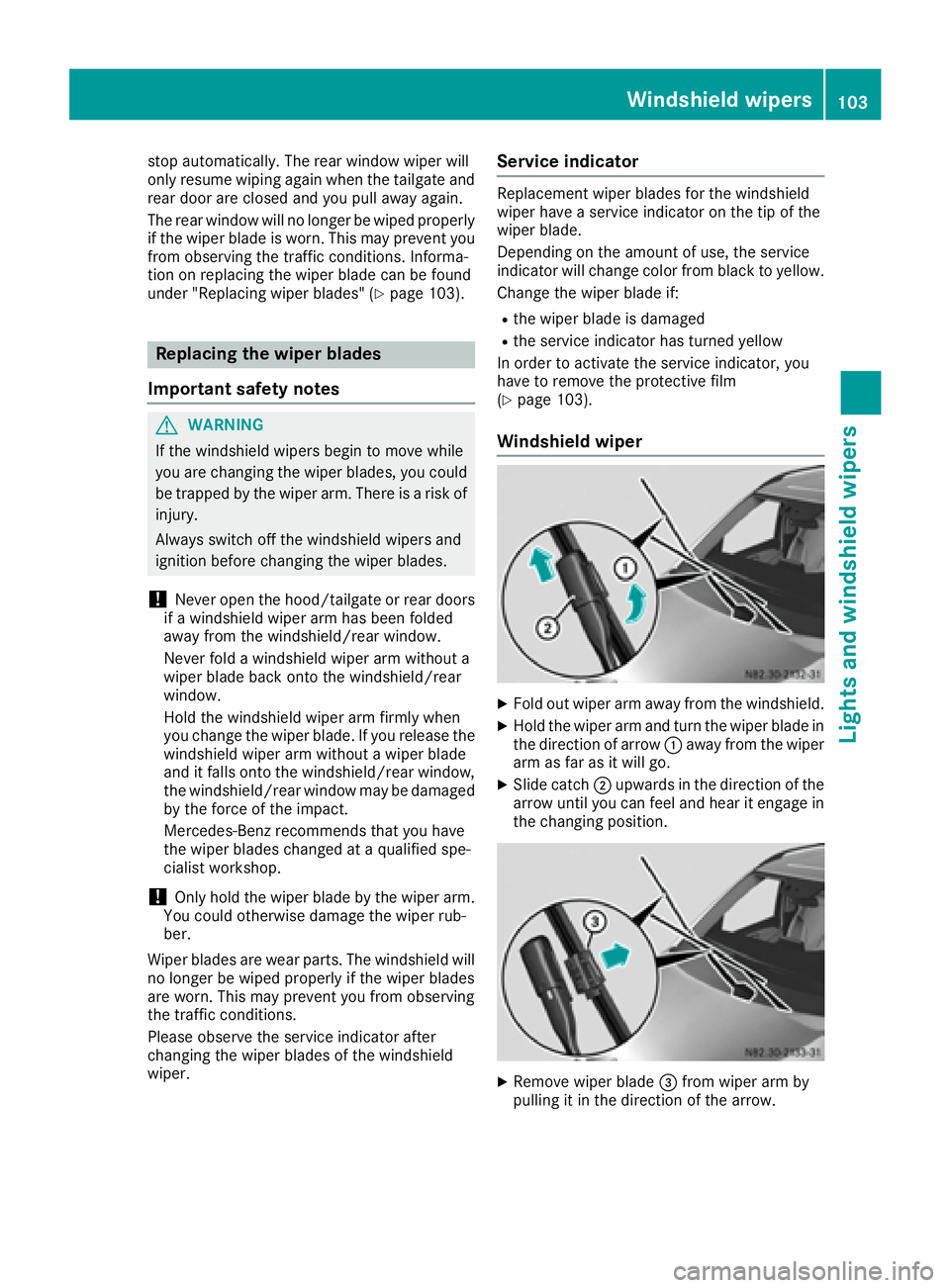
stop automatically.The rear window wiper will
only resume wiping againw hen the tailgate and
rear door are closed and you pull awaya gain.
The rear window will no longer be wiped properly
if the wiper blade is worn. This may prevent you
from observing the traffic conditions. Informa-
tion on replacing the wiper blade can be found
under "Replacing wiper blades" (
Ypage 103).
Replacing the wiper blades
Important safety notes
GWARNING
If the windshieldw ipers begin to move while
you are changing the wiper blades, you could be trapped by the wiper arm. There is arisk of
injury.
Always switch off the windshieldw ipers and
ignition before changing the wiper blades.
!Never open the hood/tailgate or rear doors
if aw indshieldw iper arm has been folded
awayf rom the windshield/rear window.
Never fold awindshieldw iper arm without a
wiper blade back onto the windshield/rear
window.
Hold the windshieldw iper arm firmly when
you change the wiper blade.Ify ou release the
windshieldw iper arm without awiper blade
and it falls onto the windshield/rear window,
the windshield/rear window may be damaged
by the force of the impact.
Mercedes-Benz recommends that you have
the wiper bladesc hanged ataqualified spe-
cialist workshop.
!Only hold the wiper blade by the wiper arm.
You could otherwise damage the wiper rub-
ber.
Wiper bladesa re wear parts. The windshieldw ill
no longer be wiped properly if the wiper blades
are worn. This may prevent you from observing
the traffic conditions.
Please observe the service indicator after
changing the wiper bladesoft he windshield
wiper.
Service indicator
Replacement wiper bladesf or the windshield
wiper have aservice indicator on the tip of the
wiper blade.
Depending on the amount of use, the service
indicator will change color from black to yellow.
Change the wiper blade if:
Rthe wiper blade is damaged
Rthe service indicator has turned yellow
In order to activate the service indicator, you
have to remove the protective film
(
Ypage 103).
Windshield wiper
XFold out wiper arm awayf rom the windshield.
XHold the wiper arm and turn the wiper blade in
the direction of arrow:awayf rom the wiper
arm as far as it will go.
XSlide catch ;upwards in the direction of the
arrow until you can feel and hear it engage in
the changing position.
XRemove wiper blade =from wiper arm by
pulling it in the direction of the arrow.
Windshield wipers103
Lights and windshield wipers
Z
Page 106 of 310
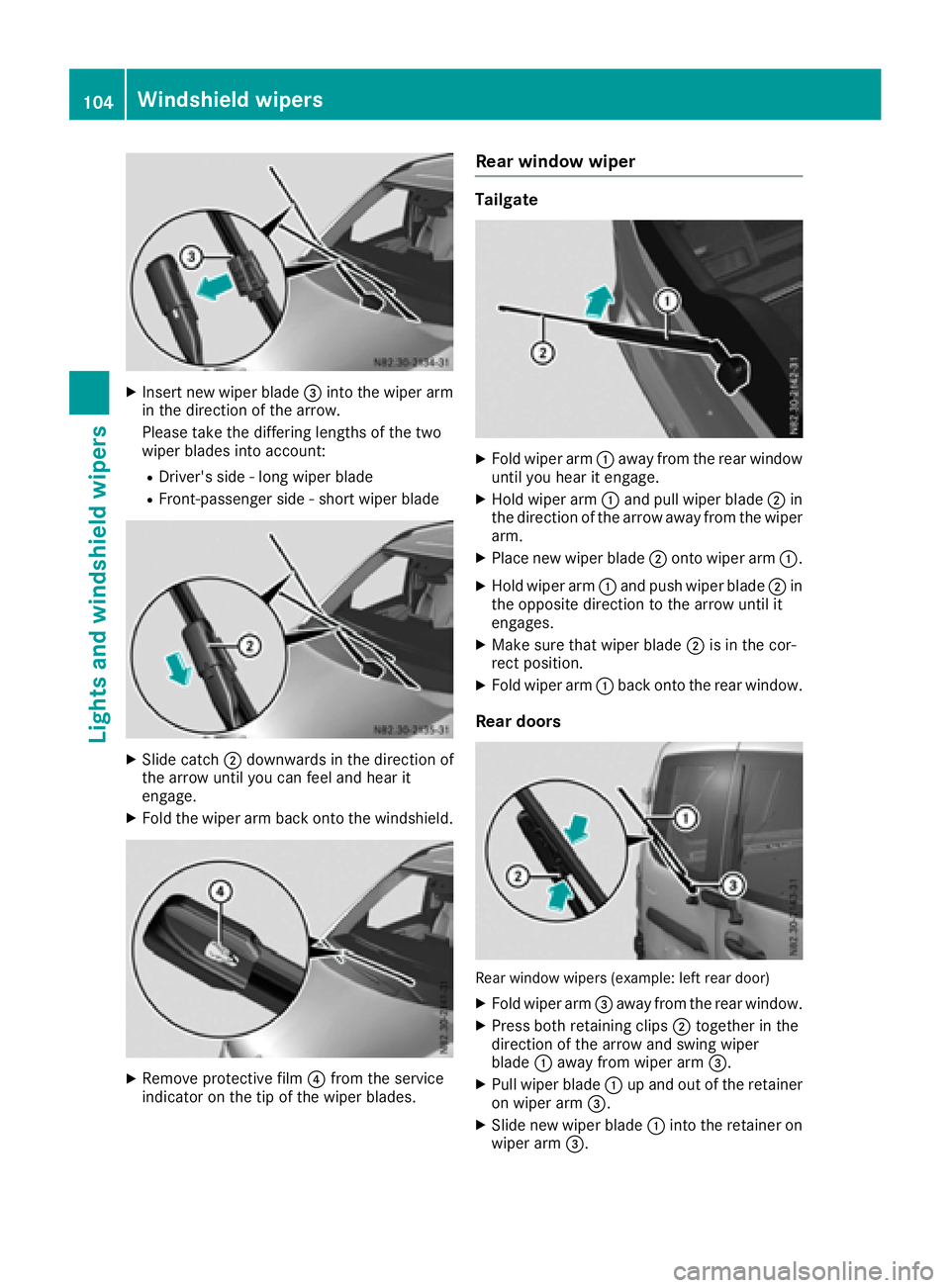
XInsert new wiper blade=into the wiper arm
in the direction of the arrow.
Please take the differing lengths of the two
wiper blades into account:
RDriver's side -long wiper blade
RFront-passenger side -short wiper blade
XSlide catch ;downwards in the direction of
the arrow until you can feel and hear it
engage.
XFold the wiper arm back onto the windshield.
XRemove protective film ?from the service
indicator on the tip of the wiper blades.
Rear window wiper
Tailgate
XFold wiper arm :awa yfrom the rear window
until you hear it engage.
XHold wiper arm :and pul lwiper blade ;in
the direction of the arrow awa yfrom the wiper
arm.
XPlace new wiper blade ;onto wiper arm :.
XHold wiper arm:and push wiper blade ;in
the opposite direction to the arrow until it
engages.
XMake sure that wiper blade ;is in the cor-
rect position.
XFold wiper arm :back onto the rear window.
Rear doors
Rea rwindow wipers (example: left rear door)
XFold wiper arm =awa yfrom the rear window.
XPress both retaining clips ;together in the
direction of the arrow and swing wiper
blade :awa yfrom wiper arm =.
XPullwiper blade :up and out of the retainer
on wiper arm =.
XSlide new wiper blade :into the retainer on
wiper arm =.
104Windshield wipers
Lights and windshield wipers
Page 121 of 310
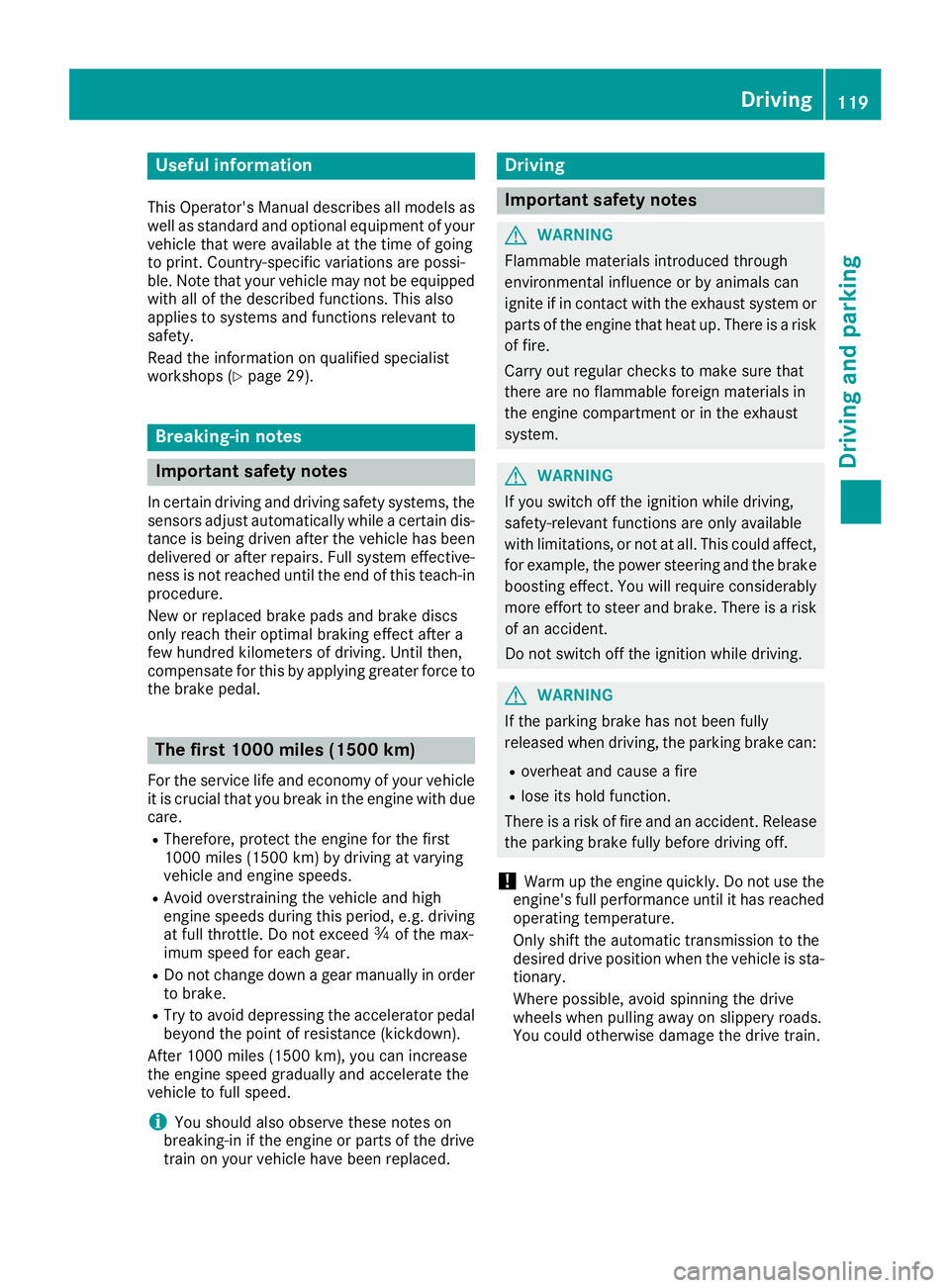
Useful information
This Operator's Manual describes all models as
well as standard and optional equipment of your
vehicle that were available at the time of going
to print.Country-specific variation sare possi-
ble. Note that your vehicle may not be equipped
with all of the described functions. This also
applies to system sand function srelevantt o
safety.
Read the information on qualified specialist
workshops (
Ypage 29).
Breaking-in notes
Important safetyn otes
In certain drivingand drivingsafetysystems, the
sensors adjust automatically while acertain dis-
tance is being driven after the vehicle has been
delivered or after repairs. Full system effective- ness is not reached until the end of this teach-in
procedure.
New or replaced brake pads and brake discs
only reach their optimal brakin geffecta fter a
few hundred kilometers of driving. Until then,
compensat efor this by applying greater forcet o
the brake pedal.
The first 1000 miles (1500 km)
For the servicel ife and economy of your vehicle
it is crucial that you break in the engin ewith due
care.
RTherefore, protect the engin efor the first
1000m iles (1500k m) by drivingatv arying
vehicle and engin espeeds.
RAvoid overstraining the vehicle and high
engin espeeds during this period, e.g. driving
at full throttle. Do not exceed Øof the max-
imum speed for each gear.
RDo not change down agear manually in order
to brake.
RTry to avoid depressingt he accelerator pedal
beyond the point of resistance (kickdown).
After 1000m iles (1500km), you can increase
the engin espeed gradually and accelerate the
vehicle to full speed.
iYou should also observet hesenotes on
breaking-in if the engin eorparts of the drive
train on your vehicle have been replaced.
Driving
Important safetyn otes
GWARNING
Flammable materials introduced through
environmental influence or by animals can
ignit eifinc ontact with the exhaust system or
parts of the engin ethat heat up. There is arisk
of fire.
Carry out regular checks to make sure that
ther eare no flammable foreign materials in
the engin ecompartmen torinthe exhaust
system.
GWARNING
If you switc hoff the ignition while driving,
safety-relevant function sare only available
with limitations, or not at all. This could affect, for example, the power steering and the brake
boosting effect. You will require considerably
more efforttos teer and brake. There is arisk
of an accident.
Do not switc hoff the ignition while driving.
GWARNING
If the parkin gbrake has not been fully
released when driving, the parkin gbrake can:
Roverheat and cause afire
Rlose its hold function.
There is arisk of fire and an accident. Release
the parkin gbrake fully before drivingo ff.
!Warm up the enginequickly. Do not use the
engine's full performanc euntil it has reached
operatin gtemperature.
Only shift the automatic transmission to the
desired drive position when the vehicle is sta-
tionary.
Where possible, avoid spinning the drive
wheels when pulling away on slippery roads.
You could otherwise damage the drive train.
Driving119
Driving and parking
Z
Page 134 of 310
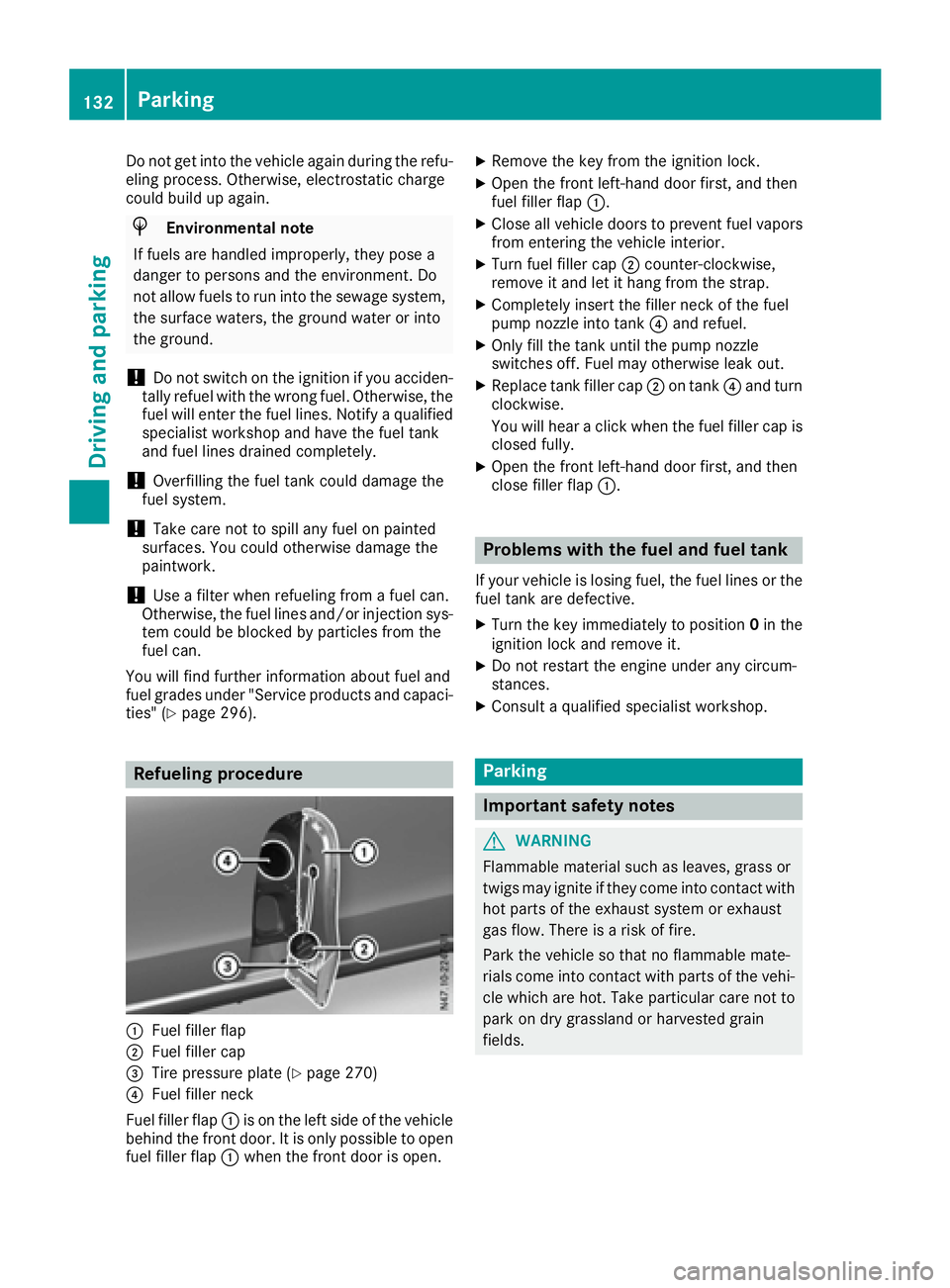
Do not getinto the vehicl eagain durin gthe refu-
eling process. Otherwise, electrostatic charge
could buil dupagain.
HEnvironmental note
If fuel sarehandled improperly, theyp osea
dange rtopersons and the environment. Do
not allo wfuels to runi nto the sewag esystem,
the surface waters ,the ground water or into
the ground.
!Do not switch on the ignition if yo uacciden-
tally refue lwitht he wrong fuel .Otherwise, the
fuel will ente rthe fuel lines .Notify aquali fied
specialis tworkshop and have the fuel tank
and fuel lines draine dcompletely.
!Overfilling the fuel tank could damage the
fuel system.
!Take car enot to spil lany fuel on painted
surfaces .You could otherwis edamag ethe
paintwork.
!Use afilter when refueling fromaf uelcan.
Otherwise, the fuel lines and/or injectio nsys-
tem could be blocke dbyparticle sfromt he
fuel can.
Yo uw illf ind furthe rinformatio nabout fuel and
fuel grade sunder "Service products and capaci-
ties" (
Ypage 296).
Refueling procedure
:Fue lfille rflap
;Fue lfille rcap
=Tire pressure plate (Ypage 270)
?Fue lfille rneck
Fue lfille rflap :is on the left side of the vehicle
behind the front door. It is onl ypossibl etoo pen
fuel fille rflap :when the front door is open.
XRemov ethe key fromt he ignition lock.
XOpen the front left-hand door first, and then
fuel fillerflap :.
XClose al lvehicl edoors to prevent fuel vapors
frome nteringthe vehicl einterior.
XTurn fuel fille rcap ; counter-clockwise,
remove it and le tithangf romt he strap.
XCompletely insert the fille rneck of the fuel
pump nozzl einto tank ?and refuel.
XOnlyf illt he tank unti lthe pump nozzle
switches off .Fuelm ayotherwis elea ko ut.
XReplace tank fille rcap ; on tank ?and turn
clockwise.
Yo uw illh ea rac lick when the fuel fille rcap is
closed fully.
XOpen the front left-hand door first, and then
close fille rflap :.
Problems with the fuela nd fueltank
If your vehicl eislosingfuel, the fuel lines or the
fuel tank ar edefective.
XTurn the key immediatel ytoposition0in the
ignition lock and remove it.
XDo not restar tthe engine under any circum-
stances.
XConsult aquali fied specialis tworkshop.
Parking
Important safety notes
GWARNING
Flammabl ematerial such as leaves, grass or
twigs mayi gnite if theyc ome into contact with
hot parts of the exhaust system or exhaust
gasf low. There is ariskoff ire.
Park the vehicl esothatnof lammabl emate-
rials come into contact with parts of the vehi-
cle which ar ehot. Take particular car enot to
park on dry grassland or harvested grain
fields.
132Parking
Driving an dparking
Page 135 of 310
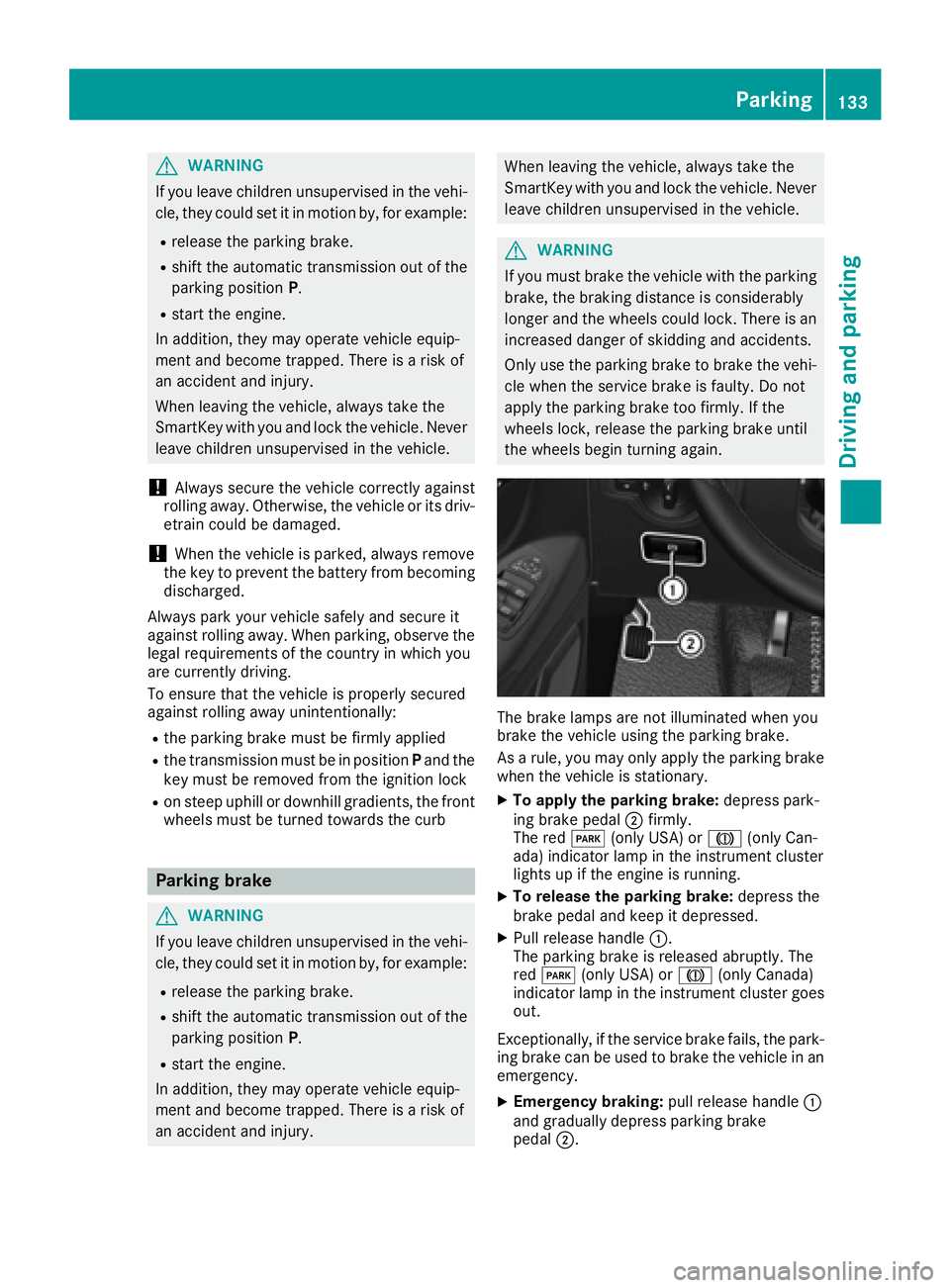
GWARNING
If you leave children unsupervised in the vehi-
cle, they coul dset it in motion by, for example:
Rrelease the parking brake.
Rshift the automatic transmission out of the
parking position P.
Rstart the engine.
In addition, they may operate vehiclee quip-
ment and become trapped. There is arisk of
an accident and injury.
When leaving the vehicle, alway stake the
SmartKey with you and lock the vehicle. Never
leave children unsupervised in the vehicle.
!Always secure the vehiclec orrectly against
rolling away. Otherwise, the vehicleori ts driv-
etrain coul dbedamaged.
!When the vehicleisp arked,alway sremove
the key to prevent the battery from becoming
discharged.
Always park you rvehicl esafel yand secure it
against rolling away. When parking, observe the
lega lrequirements of the country in which you
are currently driving.
To ensure that the vehicleisp roperly secured
against rolling awa yunintentionally:
Rthe parking brake must be firmly applied
Rthe transmission must be in position Pand the
key must be removed from the ignitio nlock
Ron steep uphill or downhill gradients, the front
wheels must be turned toward sthe curb
Parking brake
GWARNING
If you leave children unsupervised in the vehi-
cle, they coul dset it in motion by, for example:
Rrelease the parking brake.
Rshift the automatic transmission out of the
parking position P.
Rstart the engine.
In addition, they may operate vehiclee quip-
ment and become trapped. There is arisk of
an accident and injury.
When leaving the vehicle, alway stake the
SmartKey with you and lock the vehicle. Never
leave children unsupervised in the vehicle.
GWARNING
If you must brake the vehiclew ith the parking
brake, the braking distance is considerably
longer and the wheels coul dlock. There is an
increased dange rofskidding and accidents.
Only use the parking brake to brake the vehi-
cle when the service brake is faulty. Do not
apply the parking brake too firmly .Ifthe
wheels lock, release the parking brake until
the wheels begint urning again.
The brake lampsare not illuminated when you
brake the vehicleu sing the parking brake.
As arule ,you may only apply the parking brake
when the vehicleiss tationary.
XTo apply the parking brake: depress park-
ing brake pedal ;firmly.
The red F(only USA) or J(only Can-
ada )indicator lamp in the instrument cluster
lights up if the engine is running.
XTo release the parking brake: depress the
brake pedala nd keep it depressed.
XPullrelease handle :.
The parking brake is released abruptly.T he
red F (only USA) or J(only Canada)
indicator lamp in the instrument cluster goes
out.
Exceptionally,ift he service brake fails, the park-
ing brake can be used to brake the vehicleina n
emergency.
XEmergency braking: pullrelease handle :
and gradually depress parking brake
pedal ;.
Parking133
Driving and parking
Z